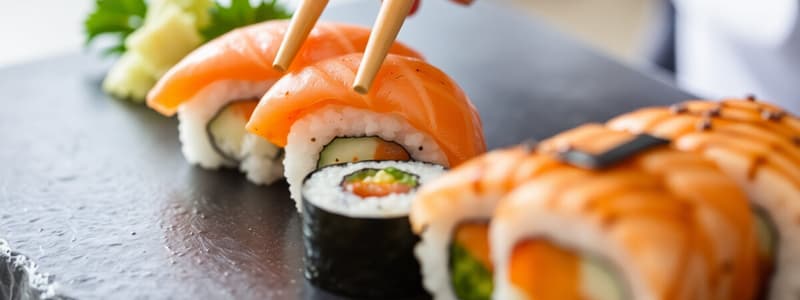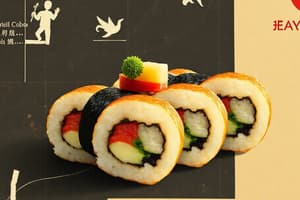Podcast
Questions and Answers
Which sushi type features a slice of fish placed on a bed of vinegared rice?
Which sushi type features a slice of fish placed on a bed of vinegared rice?
Chirashi is a type of sushi that consists of thinly sliced raw fish without rice.
Chirashi is a type of sushi that consists of thinly sliced raw fish without rice.
What is the main characteristic of Sashimi?
What is the main characteristic of Sashimi?
The crispy fried tofu pouches filled with vinegared rice are known as __________.
The crispy fried tofu pouches filled with vinegared rice are known as __________.
Match the sushi type to its description:
Match the sushi type to its description:
Flashcards
Nigiri Sushi
Nigiri Sushi
A traditional sushi style with a slice of fish or protein placed directly on vinegared rice.
Maki Sushi
Maki Sushi
Rolled sushi with various ingredients, like fish and vegetables, wrapped in vinegared rice.
Sushi Rice
Sushi Rice
Vinegared rice cooked and seasoned with rice vinegar, sugar, and salt, forming the base of sushi.
Sashimi
Sashimi
Signup and view all the flashcards
Chirashi Sushi
Chirashi Sushi
Signup and view all the flashcards
Study Notes
Types of Sushi
- Sushi encompasses a wide variety of dishes, broadly categorized by preparation methods, ingredients, and presentation.
- The core element, typically, is vinegared rice, meticulously prepared and often served with various toppings and accompaniments.
- Different types of sushi highlight specialized techniques and ingredient combinations.
Types of Sushi Preparations
-
Nigiri: A traditional style of sushi featuring a slice of fish or other protein placed directly on top of a bed of vinegared rice. Texture and freshness of the fish are paramount. Presentation is crucial; the balance and aesthetic of the nigiri piece are highly valued.
-
Maki: Rolled sushi, involving various ingredients (fish, vegetables, seaweed) wrapped within rolled rice. Maki styles are numerous and include variations like California roll (often including imitation crab), temaki (hand-rolled), and hosomaki (thin rolls). The presentation and aesthetic of the roll also heavily influences the appreciation of the dish. The selection of ingredients and type of rice directly impacts taste profiles.
-
Inari: Crispy fried tofu pouches filled with vinegared rice. The rice and tofu texture contrast are key highlights.
-
Sashimi: Thinly sliced raw fish (or other seafood) served without rice. Different cuts of fish are appropriate for different sushi types. Presentation, preparation, and the quality of the fish greatly enhance the dining experience. Selection of accompaniments can dramatically increase the enjoyment of the dish.
-
Chirashi: A rice-based dish with various ingredients scattered over the rice. Often features a wide array of seafood and vegetables, varying from type to type. The presentation strongly communicates the dish's quality.
-
Gunkan: Sushi prepared on a mound of rice, often in a small shell or boat shape or in a bowl, topped with fresh seafood. Typically uses pickled ginger on the side as a complement, along with soy sauce and wasabi. The contrasting textures and flavors are often sought after by sushi connoisseurs.
Key Ingredients and Preparation
-
Vinegared Rice (Sushi Rice): The foundation of sushi, crucial for its texture and flavor profile. The rice is cooked and then seasoned with rice vinegar, sugar, and salt in precise proportions. This process enhances aroma and texture.
-
Seafood: High-quality, fresh fish and seafood are essential for authentic and delicious sushi. The selection and preparation of the seafood are critical. Different types of fish present varied flavors and textures, which are often sought out depending on the consumer.
-
Vegetables: Used in various sushi types for nutritional and aesthetic value. Their crispness and flavor profile complement the other ingredients.
Sushi Culture and Etiquette
-
Sushi is deeply rooted in Japanese culinary traditions. There's often an emphasis on using high-quality ingredients and preparing the dishes elegantly.
-
Proper eating utensils and manners are important when enjoying sushi. A familiarity with eating sushi properly enhances the appreciation of the dish.
-
The presentation and aesthetics play a part in enjoying the dining experience. Proper service and ambiance add to the overall experience.
Studying That Suits You
Use AI to generate personalized quizzes and flashcards to suit your learning preferences.



